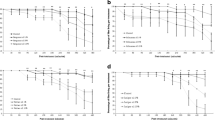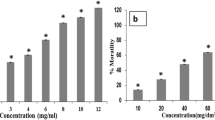Abstract
The blowfly, Chrysomya megacephala (Fabricius), and housefly, Musca domestica Linnaeus, are ubiquitous insects that have the potential to spread a variety of pathogens to humans and livestock. Pest management techniques for populations of these flies are needed. Currently, bioinsecticides, particularly those derived from plant origin, have been increasingly evaluated in controlling populations of medically important insects. In this study, an attempt was made to evaluate the efficacy and biological activity of a commercially available neem extract, containing 0.24% azadirachtin A, against C. megacephala and M. domesitca. Laboratory bioassays were performed using the feeding method of mixing neem solutions with fresh beef, once or multiple times, as food for rearing third instar. The laboratory tests showed that neem products significantly reduced larval and pupal survival, adult emergence, pupal weight, adult wing length, and fecundity on the subsequent generation, in a dose-dependent manner in both species. Efficacy was observed in the first generation and could extend to the second generation. Despite these reductions, reduction in total adult longevity was not evident for larvae fed once on neem solutions with fresh beef, and slightly earlier (≈1 week) mortality was observed in both species when they were fed as larvae on multiple doses. Adverse effects of this neem-based product toward M. domestica were slightly greater than those in C. megacephala. These data reinforced the efficacy of neem extract in reduced adult emergence and anti-fecundity in the subsequent generation. However, neem extract induced only low to moderate larval and pupal mortalities.
Similar content being viewed by others
References
Aggarwal N, Brar DS (2006) Effects of different neem preparations in comparison to synthetic insecticides on the whitefly parasitoid Encarsia sophia (Hymenoptera: Aphelinidae) and the predator Chrysoperla carnea (Neuroptera: Chrysopidae) on cotton under laboratory conditions. J Pest Sci 79:201–207
Annadurai RS, Rembold H (1993) Azadirachtin A modulates the tissue-specific 2D polypeptide patterns of the desert locust, Schistocerca gregaria. Naturwissenschaften 80:127–130
Armbruster P, Hutchinson RA (2002) Pupal mass and wing length as indicators of fecundity in Aedes albopictus and Aedes geniculatus (Diptera: Culicidae). J Med Entomol 39:699–704
Bhatt AP, Jayakrishnan A (2000) Oral myiasis: a case report. Int J Paediatr Dent 10:67–70
Bruce YA, Gounou S, Chabi-Olaye A, Smith H, Schulthess F (2004) The effect of neem (Azadiracta indica A. Juss) oil on oviposition, development and reproductive potentials of Sesamia calamistis Hampson (Lepidoptera: Noctuidae) and Eldana saccharina Walker (Lepidoptera: Pyralidae). Agric For Entomol 6:223–232
Dhar R, Dawar H, Garg S, Basir SF, Talwar GP (1996) Effect of volatiles from neem and other natural products on gonotrophic cycle and oviposition of Anopheles stephensi and An. culicifacies (Diptera: Culicidae). J Med Entomol 33:195–201
Dhiman RC, Sharma VP (1994) Evaluation of neem oil as sandfly, Phlebotomus papatasi (Scopoli) repellent in an oriental sore endemic area in Rajasthan. Southeast Asian J Trop Med Public Health 25:608–610
Di Ilio V, Cristofaro M, Marchini D, Nobili P, Dallai R (1999) Effects of a neem compound on the fecundity and longevity of Ceratitis capitata (Diptera: Tephritidae). J Econ Entomol 92:76–82
Focke M, Hemmer W, Wohrl S, Gotz M, Jarisch R, Kofler H (2003) Specific sensitization to the common housefly (Musca domestica) not related to insect panallergy. Allergy 58:448–451
Fotedar R, Banerjee U, Singh S, Verma AK (1992) The housefly (Musca domestica) as a carrier of pathogenic microorganisms in a hospital environment. J Hosp Infect 20:209–215
Greenberg B (1971) Flies and disease. Vol. I. Ecology, classification and biotic associations. Princeton University Press, New Jersey
James RR (2003) Combining azadirachtin and Paecilomyces fumosoroseus (Deuteromycotina: Hyphomycetes) to control Bemisia argentifolii (Homoptera: Aleyrodidae). J Econ Entomol 96:25–30
Jiang CP (2002) A collective analysis on 54 cases of human myiasis in China from 1995–2001. Chin Med J 115:1445–1447
Khan M, Hossain MA, Islam MS (2007) Effects of neem leaf dust and a commercial formulation of a neem compound on the longevity, fecundity and ovarian development of the melon fly, Bactocera cucurbitae (Coquillett) and the oriental fruit fly, Bactrocera dorsalis (Hendel) (Diptera: Tephritidae). Pak J Biol Sci 10:3656–3661
Kitthawee S, Edman JD, Upatham ES (1992) Anopheles dirus size and fecundity: relationship to larval density and protein accumulation. Southeast Asian J Trop Med Public Health 23:128–131
Kumarasinghe SP, Karunaweera ND, Ihalamulla RL (2000) A study of cutaneous myiasis in Sri Lanka. Int J Dermatol 39:689–694
Lucantoni L, Giusti F, Cristofaro M, Pasqualini L, Esposito F, Lupetti P, Habluetzel A (2006) Effects of a neem extract on blood feeding, oviposition and oocyte ultrastructure in Anopheles stephensi Liston (Diptera: Culicidae). Tissue Cell 38:361–371
Ma DL, Gordh G, Zalucki M (2000) Survival and development of Helicoverpa armigera (Hubner) (Lepidoptera: Noctuidae) on neem (Azadirachta indica A. Juss) leaves. Aust J Entomol 39:208–211
Maldonado MA, Centeno N (2003) Quantifying the potential pathogens transmission of the blowflies (Diptera: Calliphoridae). Mem Inst Oswaldo Cruz 98:213–216
Miller JA, Chamberlain WF (1989) Azadirachtin as a larvicide against the horn fly, stable fly, and house fly (Diptera: Muscidae). J Econ Entomol 82:1375–1378
Mitchell PL, Gupta R, Singh AK, Kumar P (2004) Behavioral and developmental effects of neem extracts on Clavigralla scutellaris (Hemiptera: Heteroptera: Coreidae) and its egg parasitoid, Gryon fulviventre (Hymenoptera: Scelionidae). J Econ Entomol 97:916–923
Monzon RB, Sanchez AR, Tadiaman BM, Najos OA, Valencia EG, de Rueda RR, Ventura JV (1991) A comparison of the role of Musca domestica (Linnaeus) and Chrysomya megacephala (Fabricius) as mechanical vectors of helminthic parasites in a typical slum area of Metropolitan Manila. Southeast Asian J Trop Med Public Health 22:222–228
Mulla MS, Su T (1999) Activity and biological effects of neem products against arthropods of medical and veterinary importance. J Am Mosq Control Assoc 15:133–152
Musabyimana T, Saxena RC, Kairu EW, Ogol CPKO, Khan ZR (2001) Effects on neem seed derivatives on behavioral and physiological responses of the Cosmopolites sordidus (Coleoptera: Curculionidae). J Econ Entomol 94:449–454
Naqvi SNH, Tabassum R, Khan MF, Yasmin N, Nurulain SM, Burney AA (2007) Toxic, residual, and teratomorphic effect of a neem extract (N-9) in comparison to Coopex 25 WP (Permethrin + Bioallethrin) against Musca domestica L. (Holland strain). Turk J Zoolog 31:127–130
Sehgal R, Bhatti HP, Bhasin DK, Sood AK, Nada R, Malla N, Singh K (2002) Intestinal myiasis due to Musca domestica: a report of two cases. Jpn J Infect Dis 55:191–193
Sharma VP, Ansari MA, Razdan RK (1993) Mosquito repellent action of neem (Azadirachta indica) oil. J Am Mosq Control Assoc 9:359–360
Sharma VP, Dhiman RC (1993) Neem oil as a sand fly (Diptera: Psychodidae) repellent. J Am Mosq Control Assoc 9:364–366
Singh G, Rup PJ, Koul O (2007) Acute, sublethal and combination effects of azadirachtin and Bacillus thuringiensis toxins on Helicoverpa armigera (Lepidoptera: Noctuidae) larvae. Bull Entomol Res 97:351–357
Singh S (2003) Effects of aqueous extract of neem seed kernel and azadiractin on the fecundity, fertility and post-embryonic development of the melonfly, Bactocera cucurbitae and the oriental fruit fly, Bactocera dorsalis (Diptera: Tephritidae). J Appl Entomol 127:540–547
Singha A, Thareja V, Singh AK (2007) Application of neem seed kernel extracts result in mouthpart deformities and subsequent mortality in Nezara viridula (L.) (Hem: Pentatomidae). J Appl Entomol 131:197–201
Steffens RJ, Schmutterer H (1982) The effect of a crude methanolic neem (Azadirachta indica) seed kernel extract on metamorphosis and quality of adults of the Mediterranean fruit fly, Ceratitis capitata Wied. (Diptera: Tephritidae). Z Angew Entomol 94:98–103
Su T, Mulla MS (1998a) Antifeedancy of neem products containing azadirachtin against Culex tarsalis and Culex quinquefasciatus (Diptera: Culicidae). J Vector Ecol 23:114–122
Su T, Mulla MS (1998b) Ovicidal activity of neem products (Azadirachtin) against Culex tarsalis and Culex quinquefasciatus (Diptera: Culicidae). J Am Mosq Control Assoc 14:204–209
Sucharit S, Tumrasvin W (1981) The survey of flies of medical and veterinary importance in Thailand. Japanese Journal of Sanitary Zoology 32:281–285
Sucharit S, Tumrasvin W, Vutikes S (1976) A survey on house flies in Bangkok and neighboring provinces. Southeast Asian J Trop Med Public Health 7:85–90
Sukontason K, Sukontason KL, Ngern-klun R, Sripakdee D, Piangjai S (2004) Differentiation of the third instar of forensically important fly species in Thailand. Ann Entomol Soc Am 97:1069–1075
Sukontason KL, Bunchoo M, Khantawa B, Piangjai S, Rongsriyam Y, Sukontason K (2007) Comparison between Musca domestica and Chrysomya megacephala as carriers of bacteria in northern Thailand. Southeast Asian J Trop Med Public Health 38:38–44
Sukontason KL, Narongchai P, Sripakdee D, Boonchu N, Chaiwong T, Ngern-Klun R, Piangjai S, Sukontason K (2005) First report of human myiasis caused by Chrysomya megacephala and Chrysomya rufifacies (Diptera: Calliphoridae) in Thailand, and its implication in forensic entomology. J Med Entomol 42:702–704
Sulaiman S, Othman MZ, Aziz AH (2000) Isolations of enteric pathogens from synanthropic flies trapped in downtown Kuala Lumpur. J Vector Ecol 25:90–93
Tumrasvin W, Sucharit S, Kano R (1978) Studies on medically important flies in Thailand. IV. Altitudinal distribution of flies belonging to Muscidae and Calliphoridae in Doi Indhanondh Mountain, Chiengmai, in early summer season. Bull Tokyo Med Dent Univ 25:77–81
Vollinger M, Schmutterer H (2002) Development of resistance to azadirachtin and other neem ingredients. In: Schmutterer H (ed) The neem tree (Azadirachta indica A. Juss) and other meliaceous plants. Sources of unique natural products for integrated pest management, medicine, industry and other purposes. Neem Foundation, Mumbai, pp 598–606
Weathersbee III AA, Tang YQ (2002) Effect of neem extract on feeding, growth, survival, and reproduction of Diaprepes abbreviatus (Coleoptera: Curculionidae). J Econ Entomol 95:661–667
Zhu L, Lin R (1999) A case of myiasis of the knee joint caused by Musca domestica vicina. Zhongguo Ji Sheng Chong Xue Yu Ji Sheng Chong Bing Za Zhi 17:349
Zumpt F (1965) Myiasis in man and animals in the Old World. Butterworths, London
Acknowledgments
Funding of this research was provided by the Royal Golden Jubilee Ph.D. Program (Grant no. PHD/0059/2546 to SS) and the Thailand Research Fund through KS (Grant no. RMU5080036). We thank the Faculty of Medicine and Chiang Mai University for subsidizing publication costs.
Author information
Authors and Affiliations
Corresponding author
Rights and permissions
About this article
Cite this article
Siriwattanarungsee, S., Sukontason, K.L., Olson, J.K. et al. Efficacy of neem extract against the blowfly and housefly. Parasitol Res 103, 535–544 (2008). https://doi.org/10.1007/s00436-008-1004-6
Received:
Accepted:
Published:
Issue Date:
DOI: https://doi.org/10.1007/s00436-008-1004-6




